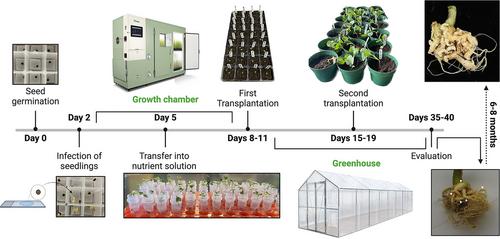{"title":"球根病原菌黄铜质菌繁殖和操作基本指南","authors":"Rasha Salih, Muhammad Asim Javed, Anne-Sophie Brochu, Priyavashini Prakash, Jean-Dominic Côté, Edel Pérez-López","doi":"10.1002/cpz1.1039","DOIUrl":null,"url":null,"abstract":"<p>Clubroot caused by the obligate parasite <i>Plasmodiophora brassicae</i> is a devastating disease affecting the canola industry worldwide. The socio-economic impact of clubroot can be significant, particularly in regions where Brassica crops are a major agricultural commodity. The disease can cause significant crop losses, leading to reduced yield and income for farmers. Extensive studies have been conducted to understand the biology and genetics of the pathogens and develop more effective management strategies. However, the basic procedures used for pathogen storage and virulence analysis have not been assembled or discussed in detail. As a result, there are discrepancies among the different protocols used today. The aim of this article is to provide a comprehensive and easily accessible resource for researchers who are interested in replicating or building upon the methods used in the study of the clubroot pathogen. Here, we discuss in detail the methods used for <i>P. brassicae</i> spore isolation, inoculation, quantification, propagation, and molecular techniques such as DNA extraction and PCR. © 2024 The Authors. Current Protocols published by Wiley Periodicals LLC.</p><p><b>Basic Protocol 1</b>: Extraction of <i>Plasmodiophora brassicae</i> resting spores and propagation</p><p><b>Support Protocol 1</b>: Evans blue staining to identify resting spore viability</p><p><b>Support Protocol 2</b>: Storage of <i>Plasmodiophora brassicae</i></p><p><b>Basic Protocol 2</b>: Generation of single spore isolates from <i>P. brassicae</i> field isolates</p><p><b>Basic Protocol 3</b>: Phenotyping of <i>Plasmodiophora brassicae</i> isolates</p><p><b>Basic Protocol 4</b>: Genomic DNA extraction from <i>Plasmodiophora brassicae</i> resting spores</p><p><b>Basic Protocol 5</b>: Molecular detection of <i>Plasmodiophora brassicae</i></p>","PeriodicalId":93970,"journal":{"name":"Current protocols","volume":null,"pages":null},"PeriodicalIF":0.0000,"publicationDate":"2024-04-25","publicationTypes":"Journal Article","fieldsOfStudy":null,"isOpenAccess":false,"openAccessPdf":"https://onlinelibrary.wiley.com/doi/epdf/10.1002/cpz1.1039","citationCount":"0","resultStr":"{\"title\":\"A Basic Guide to the Propagation and Manipulation of the Clubroot Pathogen, Plasmodiophora brassicae\",\"authors\":\"Rasha Salih, Muhammad Asim Javed, Anne-Sophie Brochu, Priyavashini Prakash, Jean-Dominic Côté, Edel Pérez-López\",\"doi\":\"10.1002/cpz1.1039\",\"DOIUrl\":null,\"url\":null,\"abstract\":\"<p>Clubroot caused by the obligate parasite <i>Plasmodiophora brassicae</i> is a devastating disease affecting the canola industry worldwide. The socio-economic impact of clubroot can be significant, particularly in regions where Brassica crops are a major agricultural commodity. The disease can cause significant crop losses, leading to reduced yield and income for farmers. Extensive studies have been conducted to understand the biology and genetics of the pathogens and develop more effective management strategies. However, the basic procedures used for pathogen storage and virulence analysis have not been assembled or discussed in detail. As a result, there are discrepancies among the different protocols used today. The aim of this article is to provide a comprehensive and easily accessible resource for researchers who are interested in replicating or building upon the methods used in the study of the clubroot pathogen. Here, we discuss in detail the methods used for <i>P. brassicae</i> spore isolation, inoculation, quantification, propagation, and molecular techniques such as DNA extraction and PCR. © 2024 The Authors. Current Protocols published by Wiley Periodicals LLC.</p><p><b>Basic Protocol 1</b>: Extraction of <i>Plasmodiophora brassicae</i> resting spores and propagation</p><p><b>Support Protocol 1</b>: Evans blue staining to identify resting spore viability</p><p><b>Support Protocol 2</b>: Storage of <i>Plasmodiophora brassicae</i></p><p><b>Basic Protocol 2</b>: Generation of single spore isolates from <i>P. brassicae</i> field isolates</p><p><b>Basic Protocol 3</b>: Phenotyping of <i>Plasmodiophora brassicae</i> isolates</p><p><b>Basic Protocol 4</b>: Genomic DNA extraction from <i>Plasmodiophora brassicae</i> resting spores</p><p><b>Basic Protocol 5</b>: Molecular detection of <i>Plasmodiophora brassicae</i></p>\",\"PeriodicalId\":93970,\"journal\":{\"name\":\"Current protocols\",\"volume\":null,\"pages\":null},\"PeriodicalIF\":0.0000,\"publicationDate\":\"2024-04-25\",\"publicationTypes\":\"Journal Article\",\"fieldsOfStudy\":null,\"isOpenAccess\":false,\"openAccessPdf\":\"https://onlinelibrary.wiley.com/doi/epdf/10.1002/cpz1.1039\",\"citationCount\":\"0\",\"resultStr\":null,\"platform\":\"Semanticscholar\",\"paperid\":null,\"PeriodicalName\":\"Current protocols\",\"FirstCategoryId\":\"1085\",\"ListUrlMain\":\"https://onlinelibrary.wiley.com/doi/10.1002/cpz1.1039\",\"RegionNum\":0,\"RegionCategory\":null,\"ArticlePicture\":[],\"TitleCN\":null,\"AbstractTextCN\":null,\"PMCID\":null,\"EPubDate\":\"\",\"PubModel\":\"\",\"JCR\":\"\",\"JCRName\":\"\",\"Score\":null,\"Total\":0}","platform":"Semanticscholar","paperid":null,"PeriodicalName":"Current protocols","FirstCategoryId":"1085","ListUrlMain":"https://onlinelibrary.wiley.com/doi/10.1002/cpz1.1039","RegionNum":0,"RegionCategory":null,"ArticlePicture":[],"TitleCN":null,"AbstractTextCN":null,"PMCID":null,"EPubDate":"","PubModel":"","JCR":"","JCRName":"","Score":null,"Total":0}
引用次数: 0
A Basic Guide to the Propagation and Manipulation of the Clubroot Pathogen, Plasmodiophora brassicae
Clubroot caused by the obligate parasite Plasmodiophora brassicae is a devastating disease affecting the canola industry worldwide. The socio-economic impact of clubroot can be significant, particularly in regions where Brassica crops are a major agricultural commodity. The disease can cause significant crop losses, leading to reduced yield and income for farmers. Extensive studies have been conducted to understand the biology and genetics of the pathogens and develop more effective management strategies. However, the basic procedures used for pathogen storage and virulence analysis have not been assembled or discussed in detail. As a result, there are discrepancies among the different protocols used today. The aim of this article is to provide a comprehensive and easily accessible resource for researchers who are interested in replicating or building upon the methods used in the study of the clubroot pathogen. Here, we discuss in detail the methods used for P. brassicae spore isolation, inoculation, quantification, propagation, and molecular techniques such as DNA extraction and PCR. © 2024 The Authors. Current Protocols published by Wiley Periodicals LLC.
Basic Protocol 1: Extraction of Plasmodiophora brassicae resting spores and propagation
Support Protocol 1: Evans blue staining to identify resting spore viability
Support Protocol 2: Storage of Plasmodiophora brassicae
Basic Protocol 2: Generation of single spore isolates from P. brassicae field isolates
Basic Protocol 3: Phenotyping of Plasmodiophora brassicae isolates
Basic Protocol 4: Genomic DNA extraction from Plasmodiophora brassicae resting spores
Basic Protocol 5: Molecular detection of Plasmodiophora brassicae


